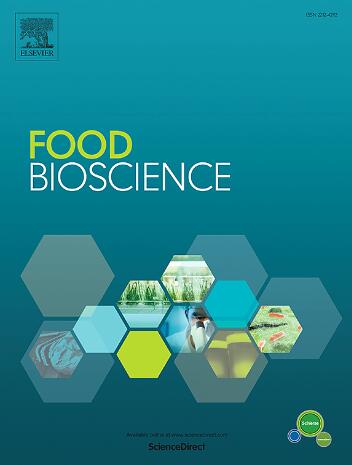百香果皮果胶通过肠道微生物群和胰岛素敏感性调节改善高脂肪饮食引起的肥胖的葡萄糖和脂质代谢
IF 5.9
1区 农林科学
Q1 FOOD SCIENCE & TECHNOLOGY
引用次数: 0
摘要
本研究探讨了百香果皮果胶(PFP)对高脂饮食小鼠糖脂代谢的影响。50只小鼠分为5组:(1)正常饮食组(ND), (2) HFD组,(3)HFD组加奥利司他(20 mg/kg/d,阳性对照,PC-HFD), (4) HFD组加300 mg/kg/d PFP (PFP1), (5) HFD组加600 mg/kg/d PFP (PFP2),连续8周。与HFD相比,PFP1和PFP2组均表现出体重(- 3.9%和- 4.4%)、血清葡萄糖(- 17.6%和- 20.4%)和肝脏脂质积累(油红o染色区- 68.6%和- 65.2%)的显著降低。16S rRNA分析显示,PFP增加了产生scfa的肠道细菌。Tax4Fun2分析预测pfp处理小鼠中与宿主胰岛素抵抗途径相关的微生物功能电位的富集。粪便代谢组学和SCFA分析显示粪便中丙酮酸、甘油三酯和乙酸的水平增加。肝脏转录组学显示胰岛素抵抗通路中有7个基因富集。对16S rRNA和多组学数据的综合分析表明,PFP干预与胰岛素抵抗和肝脂质代谢相关通路的调节之间存在关联。qRT-PCR分析显示,PFP增加了PI3K、AKT、INSR、IRS1和GLUT4的mRNA表达,降低了G6P的表达。这些发现表明,PFP可能通过调节胰岛素敏感性和肝脏脂质处理来改善hfd喂养小鼠代谢失调的某些方面。本文章由计算机程序翻译,如有差异,请以英文原文为准。
Passion fruit peel pectin improves glucose and lipid metabolism in high-fat diet-induced obesity through gut microbiota and insulin sensitivity regulation
This study investigated the effects of passion fruit peel pectin (PFP) on glucose and lipid metabolism in mice fed a high-fat diet (HFD). Fifty mice were divided into five groups: (1) normal diet (ND), (2) HFD, (3) HFD with orlistat (20 mg/kg/day, positive control, PC-HFD), (4) HFD with 300 mg/kg/day PFP (PFP1), and (5) HFD with 600 mg/kg/day PFP (PFP2) for 8 weeks. Compared to HFD, both PFP1 and PFP2 groups exhibited significant reductions in body weight (−3.9 % and −4.4 %), serum glucose (−17.6 % and −20.4 %), and hepatic lipid accumulation (−68.6 % and −65.2 % in oil red O-stained area). 16S rRNA analysis showed that PFP increased SCFA-producing gut bacteria. Tax4Fun2 analysis predicted enrichment of microbial functional potential related to the host insulin resistance pathway in PFP-treated mice. Fecal metabolomics and SCFA analyses revealed increased levels of pyruvic acid, triglycerides, and acetic acid in feces. Liver transcriptomics showed enrichment of 7 genes in the insulin resistance pathway. Integrated analyses of 16S rRNA and multi-omics data suggested associations between PFP intervention and modulation of pathways related to insulin resistance and hepatic lipid metabolism. qRT-PCR analysis demonstrated that PFP increased the mRNA expression of PI3K, AKT, INSR, IRS1, and GLUT4, while decreasing G6P expression. These findings suggest that PFP might improve certain aspects of metabolic dysregulation in HFD-fed mice, potentially through modulation of insulin sensitivity and hepatic lipid handling.
求助全文
通过发布文献求助,成功后即可免费获取论文全文。
去求助
来源期刊

Food Bioscience
Biochemistry, Genetics and Molecular Biology-Biochemistry
CiteScore
6.40
自引率
5.80%
发文量
671
审稿时长
27 days
期刊介绍:
Food Bioscience is a peer-reviewed journal that aims to provide a forum for recent developments in the field of bio-related food research. The journal focuses on both fundamental and applied research worldwide, with special attention to ethnic and cultural aspects of food bioresearch.
 求助内容:
求助内容: 应助结果提醒方式:
应助结果提醒方式:


